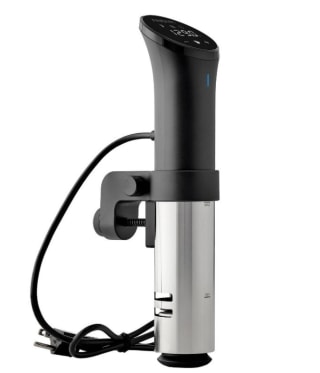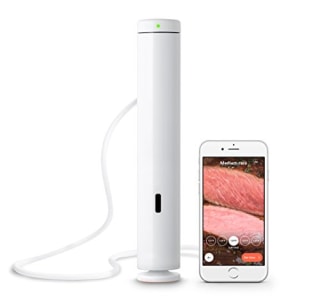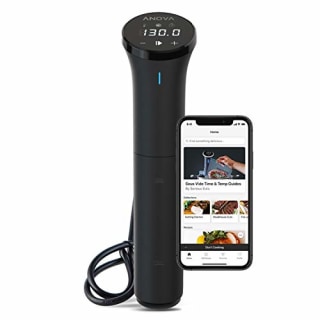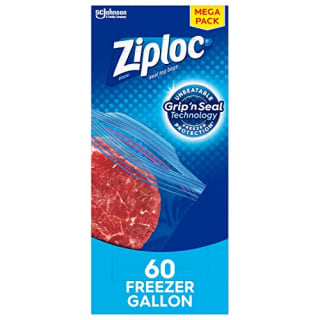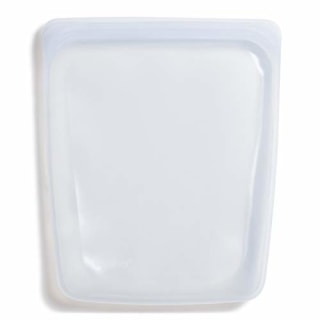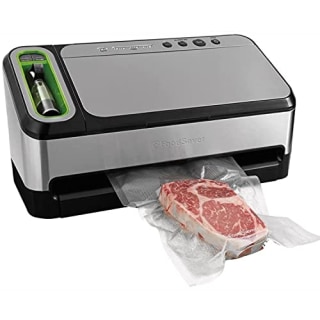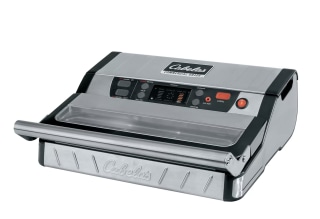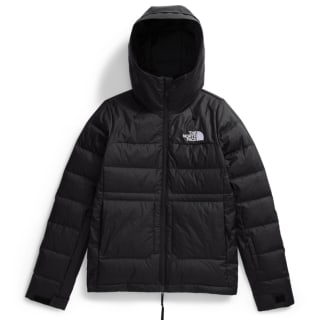Sous vide cooking is relatively simple, according to chefs. It may sound intimidating at first, but the concept itself is pretty straightforward: Translating to "under vacuum" in French, sous vide is a cooking technique that involves placing food in an airtight container and submerging it in a pot of temperature-controlled water. The best part about the process for many home chefs is that it’s almost entirely hands-off — there’s no contact with a heat source or most other kinds of cooking tools, and you can cook meat and fish over a determined amount of time without needing to regulate the temperature yourself. The airtight bags used in sous vide cooking also lock in the juices, herbs and spices, allowing for a more flavorful dish.
SKIP AHEAD How sous vide cooking works | Benefits of sous vide cooking
To get started on your sous vide cooking journey, you’ll need the right equipment and a solid understanding of the process. We spoke to chefs and sous vide experts about how sous vide cooking works and what kind of foods you can cook through this process — as well as some of their recommended products to try out.
The best sous vide immersion cookers
Experts told us that an immersion cooker is the most important piece of equipment for sous vide cooking since it’s designed to precisely regulate the temperature. Below, we highlighted their recommendations for the best immersion cookers to buy.
Anova Precision Cooker
Daniel Shumski, a recipe developer and author of “How to Sous Vide,” said he uses the Anova Precision Cooker since it’s “simple and straightforward” without the bells and whistles of some other sous vide cookers. “I don’t need to be able to talk to it or control it from the other side of the room,” he said. While it gives users the option to connect to their smartphones using the Anova Culinary app, you can also select your desired temperature using the controls directly on the LED display. Like many immersion cookers, the Anova Precision Cooker features an adjustable and removable clamp that can attach to your pot or container, according to the brand. Temperature settings range from 77 degrees to 210 degrees Fahrenheit.
Breville Joule Sous Vide
Tanya Cauthen, owner and head butcher at Belmont Butchery, said she uses the Breville Joule for her own sous vide cooking due to both the machine and app’s ease of use — she also noted it’s a favorite among the staff at her butchery. The Joule is a more compact option than the Anova Precision cooker, weighing about 1 pound and measuring 11 inches high, according to the brand. It features both Bluetooth and Wi-Fi connectivity to use alongside the Joule app, which the brand says lets you start the cooker and determine the time needed based on your desired doneness level. According to ChefSteps, a subsidiary of Breville, you can set the Breville anywhere between 20 degrees and 208 degrees Fahrenheit.
Anova Precision Cooker Nano
Shumski said the Anova Precision Cooker Nano can be a “reasonable upgrade” from the standard Anova Precision Cooker if you want a less expensive and lighter option that connects to your phone via Bluetooth — a feature that the standard does not have. However, unlike the standard Precision Cooker, the Nano does not feature Wi-Fi connectivity and equips a fixed clamp. According to Anova, the Nano’s temperature ranges from 32 degrees to 197 degrees Fahrenheit.
Monoprice Immersion Cooker
“If I were starting out, this is the immersion cooker I would pick,” said Shumski, adding that the Monoprice cooker lets you get familiar with the sous vide process without spending a lot. It features a digital LED screen that allows you to set the cooking temperature and time, and equips an adjustable clamp. This model is manually adjusted, meaning it doesn’t feature Wi-Fi or Bluetooth connectivity like the other options on this list.
The best sous vide equipment to shop
To determine the best additional sous vide supplies outside of immersion cookers, we talked to our experts about the type of items to look for — including food-grade freezer bags and vacuum sealers — and rounded up their top picks below.
Ziploc Gallon Food Storage Freezer Bags
Since a vacuum sealer can be expensive, our experts said food storage bags from Ziploc can be a great inexpensive alternative. For home cooks, Lynae Gurnsey, a chef and instructor at the Auguste Escoffier School of Culinary Arts, recommended the freezer bags since they “hold up best when submerged in heated water.” However, experts noted to ensure all of the air is squeezed out of the bag before submerging it and to ensure it’s closed tightly so no water gets in.
Stasher Half Gallon Bag
Shumski said reusable silicone storage bags like these ones from Stasher can be a good option for sous vide cooking as well as an efficient way to avoid single-use plastic. Stasher offers a variety of colors and sizes, ranging from the Stand-up Mega Bag that can hold up to 104 fluid ounces to the Quart Bag with a 40-fluid-ounce capacity.
FoodSaver V4840 2-in-1 Vacuum Sealer Machine
This vacuum sealer from FoodSaver is the one Shumski says he reaches for the most. The brand says this machine is fully automatic, which means you can simply place a pre-cut bag at the open end of the appliance and it’ll automatically start the vacuum sealing process. For zippered bags, the machine comes with a retractable handheld sealer that’ll vacuum seal with a push of a button, according to FoodSaver. You can pair this with the FoodSaver vacuum seal bags.
Cabela's Commercial-Grade Vacuum Sealer
For frequent or commercial-grade use, Gurnsey recommended this vacuum sealer from Cabela’s, which features Smart Heat Technology for larger jobs that lets you continuously seal without having to wait in between, according to the brand. Made of durable stainless steel, this vacuum sealer features a built-in LED light that the brand says lets you monitor the sealing process, as well as touch control panels to adjust multiple sealing modes for different types of foods, including Dry, Moist and Marinate.
How exactly does sous vide cooking work?
The most important piece of equipment is the sous vide immersion cooker. This device can precisely regulate water temperature and helps the water — and, in turn, your food — maintain that temperature no matter how much time passes. “Sous vide cooking is all about cooking at precisely regulated temperatures, and the immersion cooker is the piece of equipment that makes that possible,” Shumski said.
In addition to the immersion cooker, you’ll need a large pot or a heat-proof storage container to create the water bath. You’ll also need food-safe bags, whether that’s vacuum sealable bags (along with a vacuum sealer), resealable plastic bags like Ziploc bags or reusable silicone bags. While the experts we spoke to noted vacuum seal bags aren’t absolutely necessary, it is a plus if you want to ensure your food stays locked in and water stays out, according to Cauthen.
Once you have all your equipment together, Shumski listed the following general steps for sous vide cooking:
- Place your food in a bag and remove the air from it.
- Use the immersion cooker to heat the water to the specified temperature in your recipe or immersion cooker guide.
- Drop the bag in the water.
- Leave the bag in the water for the specified time as noted by your immersion cooker or recipe.
- Remove the food from the bag, dry it off and do any finishing steps like searing or plating.
Sous vide cooking is best known for precisely cooking meats and fish, but you can also cook an array of other foods with a sous vide cooker as long as you have the time and the right equipment. Experts told us you can cook everything from eggs and vegetables to desserts like creme brulee and chocolate cake.
What are the benefits of sous vide cooking?
Precision cooking and consistency, which eliminate a lot of the guesswork from the cooking process, are two of the main benefits of sous vide cooking. A steak, for example, is “cooked perfectly from edge to edge” with a sous vide cooker and doesn’t need to be constantly monitored, Shumski said.
“It can be easy to over- or undercook expensive cuts of meat, but using the immersion circulator allows us to set it and forget it,” Gurnsey added. That’s because the temperature “doesn’t fluctuate more than a fraction of a degree,” she noted.
It takes some research and trial and error to know the exact time and temperature for each recipe.
Lynae Gurnsey, chef and instructor at the Auguste Escoffier School of Culinary Arts
Another big advantage of sous vide cooking for meats in particular is it allows the food to cook in its own juices, so there’s minimal loss of flavor, according to Gurnsey. She mentioned sous vide cooking can be great for tougher cuts of meat that require “low and slow cooking methods'' — including prime rib, skirt steak and round roast — because there’s ultimately greater “flavor retention and tenderness.”
Sous vide: Time and temperature
Because the water temperature doesn’t get higher than what you set it to with a sous vide cooker, meats and other types of foods manage to cook uniformly — however, it takes a lot longer than if you were to cook it using a stove or grill, according to Cauthen.
The experts we spoke to noted the time it takes to sous vide depends on the type of food you’re cooking (fish, for example, takes considerably less time to cook than tough meats), the level of doneness you’re aiming for and the thickness and weight of your meat. Typically, the guides and apps that come with the immersion cooker will suggest how long to cook your foods for.
“It takes some research and trial and error to know the exact time and temperature for each recipe,” said Gursney.
Our experts emphasized that the careful regulation of the water temperature means the timing doesn’t have to be exact with sous vide cooking, and you can leave food in there a bit longer than the recipe calls for without any serious concerns. However, Shumski warned that cooking at lower temperatures (130 degrees Fahrenheit or lower) for more than two hours can potentially be dangerous, and both Cauthen and Gurnsey noted that holding meat at a certain temperature for too long can change the texture, and usually not for the better.
“One misconception is that you can not overcook in a sous vide machine,” said Gurnsey. “We expect meat to have some structure — when the proteins are cooked too long, the meat can become too mushy and has an undesirable texture.”
Catch up on Select’s in-depth coverage of personal finance, tech and tools, wellness and more, and follow us on Facebook, Instagram and Twitter to stay up to date.



